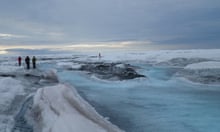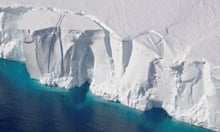The gigantic Boulder glacier is in Montana’s glacier park; these images, charting its decline, were taken between 1932 and 1988. According to the US Geological Survey, this pair of photos inspired the institution to document glacier and landscape change using oblique photography.
The gigantic Grinnell glacier in Glacier park, Montana on the Canada-US border is slowly disappearing. These images record the retreat between 1938 and 2016.
The Agassiz Glacier is also in Glacier park, a vast area that encompasses over 1m acres (404,685 hectares) and parts of two mountain ranges. The landscape here has been carved out by glacial action over millennia. These images record the decline of Agassiz between 1913 and 2007.
The Columbia glacier is a large tidewater glacier, flowing down the side of the Chugach mountain towards Prince William Sound in south-eastern Alaska. False-colour images, captured by Landsat satellites, show how the glacier and the surrounding landscape has changed in recent years.
Since the 1980s, the terminus – the tip of the glacier that points towards the sea – has retreated more than 20km (12 miles) to the north. In some years, the terminus retreated more than a kilometre, though the pace has been uneven.
A combination photograph shows a historic image taken in 1928 of the Upsala Glacier in Patagonia, Argentina contrasted with a 2004 photograph of the same view. The pictures illustrate the extent to which the climate crisis has caused the ice to melt away this century.
Joris Thijssen, a Greenpeace campaigner, said: “Rising temperatures are causing glaciers to melt all over the world. Here in Patagonia, they are disappearing at a rate of 42 cubic kilometres every year – faster than anywhere else on Earth.”
Some flowing bodies of ice in the South Patagonian Icefield are identified simply with the prefix HPS (Hielo Patagónico Sur, which is Spanish for “southern Patagonian icefield”) followed by an identifying number. The picture shows HPS-12.
Glaciers are thinning and retreating all over the south Patagonian icefield, the largest contiguous icefield in the southern hemisphere outside Antarctica. But researchers have noted that “most of the glaciers of the icefield are decaying, with several undergoing ‘catastrophic’ retreat.”
In 1985, HPS-12 measured 26km long. The retreat accelerated in the late 1990s, and by 2015, three glaciers that fed into HPS-12 from the sides were cut off. By 2017, the glacier was less than 13km long. According to Mauri Pelto, a glaciologist who wrote about HPS-12 on his blog, “this retreat along with Jorge Montt is the largest in Chile in the last 30 years.”
The Eiger, Guggi and Giesen glaciers are photographed here from near the Jungfrau between 1890 and 1900 in Wengen, Switzerland and on 27 August 2019.
The Aletsch glacier is the largest glacier in the Alps and in an area that has now been declared a Unesco world heritage site. Here it can seen as it was in 1865, seen from Belalp, Switzerland and as it is more recently on 3 September 2019.
The Trient glacier as it was in 1891, seen in Trient, Switzerland and on 26 August 2019.
In 1919, the Swiss pilot and photographer Walter Mittelholzer flew over Mont Blanc in a biplane to photograph the alpine landscape. Exactly 100 years later, researchers from the University of Dundee in Scotland recreated his photographs to show the impact that the climate crisis has had upon the mountain’s glaciers.
These images show combination of aerial views of the Mer de Glace glacier, near Chamonix, south-eastern France taken in 1919 and August 2019.
A combination of handout pictures taken on summer 2006, and 4 September 2019, and provided by Matthias Huss, glaciologist at the ETH technical university in Zurich, show the now vanished Pizol glacier in the Swiss Alps, above Mels. In 2019 Swiss mourners held a “funeral march” up a steep mountainside to mark the disappearance of the Alpine glacier amid growing global alarm over the climate crisis.
This combination of 14 September 1986 (left) and 1 August 2019 photos provided by Nasa show the shrinking of the Okjökull glacier on the Ok volcano in west-central Iceland. A geological map from 1901 estimated Okjökull spanned an area of about 38 sq km (15 sq miles). In 1978, aerial photography showed the glacier was 3 sq km. In 2019, less than 1 sq km remains.
Both photographs were taken from aircraft, most recently in an effort by Bjørk and colleagues to re-photograph the sites of Greenland’s fast-changing glaciers. The historic photographs showed a remarkably quick retreat between 1900 and 1930 –more rapid than in the past 15 years. The Little ice age had lost its grip on the region and temperatures climbed.
As the Arctic climate warms again, the information from historic photographs should help researchers understand how quickly glaciers can react to temperature changes.
These images show the Khumbu glacier, which lies near to Mount Everest in Nepal. They map the period between 1956 and 2007.
Taboche with its peak of 6,367 metres, and its neighbour Jobo Laptsan preside over the lower Khumbu valley. At their base is the path to Everest base camp.
Tsholo Tso is a moraine dammed lake at the foot of Jobo Laptsan, seen here as a white, glacial-like feature, blocking the lake. The first image was taken in 1950, the second from the same point in 2007. The clean, debris-free glaciers and ice nestled below the Taboche summit have been reduced considerably by recent warming trends. The ice in the small glaciers below the ridgelines to the right (north) has suffered the most, perhaps because of its lower altitude, below 6000 metres.
Zachariæ Isstrøm, in Greenland, is now, according to a 2015 study, in accelerated retreat. This vast glacier drains about 5% of the Greenland ice sheet, according to Nasa, and holds enough water to raise the global sea level by more than 46cm (18in) if it were to melt completely. The images here were taken between 1999 and 2015.
Antarctica’s Thwaites glacier has been in the spotlight in recent years, as scientists have undertaken a multi-part international project to study the vast glacier from all angles. This image pair demonstrates the changes that have occurred since 2001 to 2019. Both images show the glacier where it exits the land in west Antarctica and stretches over the Amundsen Sea as thick floating ice.
Warm water has recently been recorded near the Thwaites glacier grounding line – the location where the glacial ice rests on the seafloor. “What the satellites are showing us is a glacier coming apart at the seams,” said Ted Scambos, a senior scientist at the University of Colorado. “Every few years a new area seems to be letting go and accelerating. Like taffy being stretched out, this glacier is being drawn into the ocean.”









